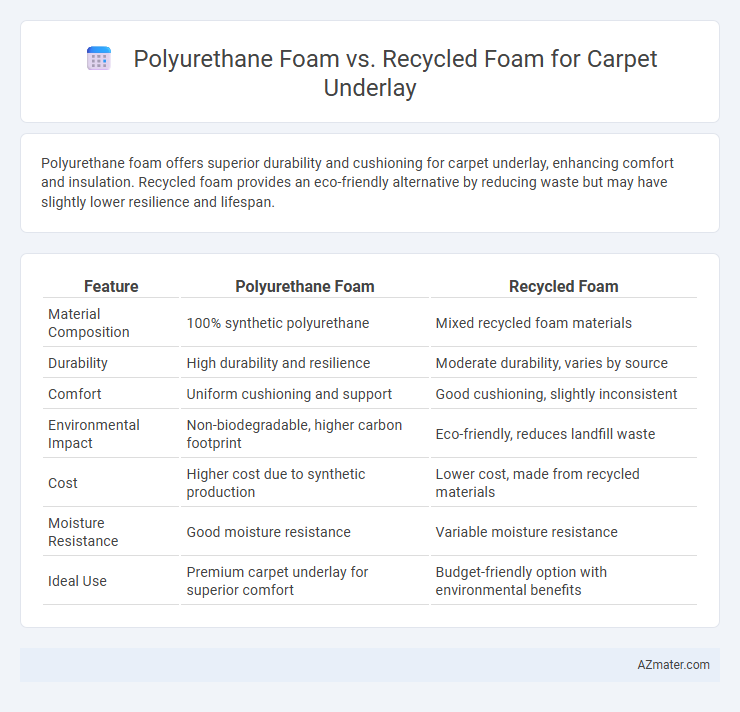Polyurethane foam offers superior durability and cushioning for carpet underlay, enhancing comfort and insulation. Recycled foam provides an eco-friendly alternative by reducing waste but may have slightly lower resilience and lifespan.
Table of Comparison
| Feature | Polyurethane Foam | Recycled Foam |
|---|---|---|
| Material Composition | 100% synthetic polyurethane | Mixed recycled foam materials |
| Durability | High durability and resilience | Moderate durability, varies by source |
| Comfort | Uniform cushioning and support | Good cushioning, slightly inconsistent |
| Environmental Impact | Non-biodegradable, higher carbon footprint | Eco-friendly, reduces landfill waste |
| Cost | Higher cost due to synthetic production | Lower cost, made from recycled materials |
| Moisture Resistance | Good moisture resistance | Variable moisture resistance |
| Ideal Use | Premium carpet underlay for superior comfort | Budget-friendly option with environmental benefits |
Introduction to Carpet Underlays
Carpet underlays play a crucial role in enhancing comfort, insulation, and durability of flooring. Polyurethane foam underlays offer superior cushioning, resilience, and moisture resistance, making them ideal for high-traffic areas. Recycled foam underlays provide an eco-friendly alternative by utilizing post-consumer materials while maintaining adequate support and sound insulation properties.
What is Polyurethane Foam Underlay?
Polyurethane foam underlay is a popular cushioning material used beneath carpets to enhance comfort, insulation, and durability. It is manufactured from polyurethane, a flexible synthetic polymer known for its excellent resilience, shock absorption, and moisture resistance. This underlay provides superior support and longevity compared to recycled foam options, making it a preferred choice for high-traffic areas and premium carpet installations.
What is Recycled Foam Underlay?
Recycled foam underlay is made from repurposed polyurethane foam scraps, providing an eco-friendly alternative to traditional polyurethane foam underlays used beneath carpets. It offers similar cushioning and insulation properties while reducing landfill waste and conserving raw materials. This sustainable underlay option supports environmental responsibility without compromising comfort or durability in flooring applications.
Comfort and Cushioning Comparison
Polyurethane foam offers superior comfort and cushioning due to its dense cellular structure that provides consistent support and resilience underfoot. Recycled foam, while environmentally friendly, often has variable density and may compress more quickly, resulting in reduced cushioning effectiveness over time. Carpet underlays made from polyurethane foam typically deliver longer-lasting comfort and better shock absorption compared to recycled foam alternatives.
Durability and Lifespan
Polyurethane foam underlay offers superior durability with a typical lifespan of 8 to 15 years, thanks to its dense cellular structure that resists compression and maintains cushioning over time. Recycled foam underlays, while environmentally friendly, generally have a shorter lifespan of 5 to 10 years due to variable material quality and reduced resilience. Choosing polyurethane foam underlay ensures longer-lasting performance and consistent support beneath carpets in high-traffic areas.
Environmental Impact and Sustainability
Polyurethane foam carpet underlay typically relies on petrochemical-based materials, contributing to higher carbon emissions and limited biodegradability. Recycled foam underlay, often sourced from repurposed polyurethane or other foam waste, significantly reduces landfill use and lowers the environmental footprint by minimizing raw material extraction. Sustainable carpet underlay choices prioritize recycled foam for its ability to conserve resources, promote circular economy principles, and reduce overall ecological impact.
Cost Differences: Polyurethane vs Recycled Foam
Polyurethane foam for carpet underlay generally costs more upfront due to its superior durability and cushioning properties, making it a premium choice for long-term performance. Recycled foam offers a more budget-friendly alternative as it is made from repurposed materials, reducing both production costs and environmental impact. Although recycled foam has a lower initial price, it may have a shorter lifespan, potentially leading to higher replacement expenses over time compared to polyurethane foam.
Installation and Maintenance Considerations
Polyurethane foam carpet underlay offers superior cushioning and resilience, making it easier to install with a uniform thickness that maintains carpet stability over time. Recycled foam underlay may require additional care during installation due to potential density inconsistencies, which can affect overall carpet support and feel. Maintenance for polyurethane foam is generally straightforward as it resists compression and moisture buildup, while recycled foam may need more frequent inspection and replacement because of variable durability and potential degradation from prolonged use.
Health and Indoor Air Quality
Polyurethane foam carpet underlays can emit volatile organic compounds (VOCs) such as toluene and formaldehyde, potentially impacting indoor air quality and causing respiratory irritation. Recycled foam underlays, often made from post-consumer polyurethane waste, tend to have lower emissions due to reduced use of fresh chemicals and improved manufacturing standards focused on sustainability. Choosing recycled foam supports healthier indoor environments by minimizing off-gassing and reducing exposure to harmful airborne pollutants over time.
Choosing the Right Underlay for Your Carpet
Polyurethane foam underlay offers superior cushioning and durability, enhancing carpet lifespan and comfort while providing excellent insulation properties. Recycled foam underlay presents an eco-friendly option with good resilience and cost-effectiveness, appealing to environmentally conscious homeowners seeking sustainable solutions. Prioritize factors such as foam density, thickness, and thermal insulation to select the underlay that matches your carpet type, traffic levels, and budget requirements.

Infographic: Polyurethane foam vs Recycled foam for Carpet underlay
 azmater.com
azmater.com